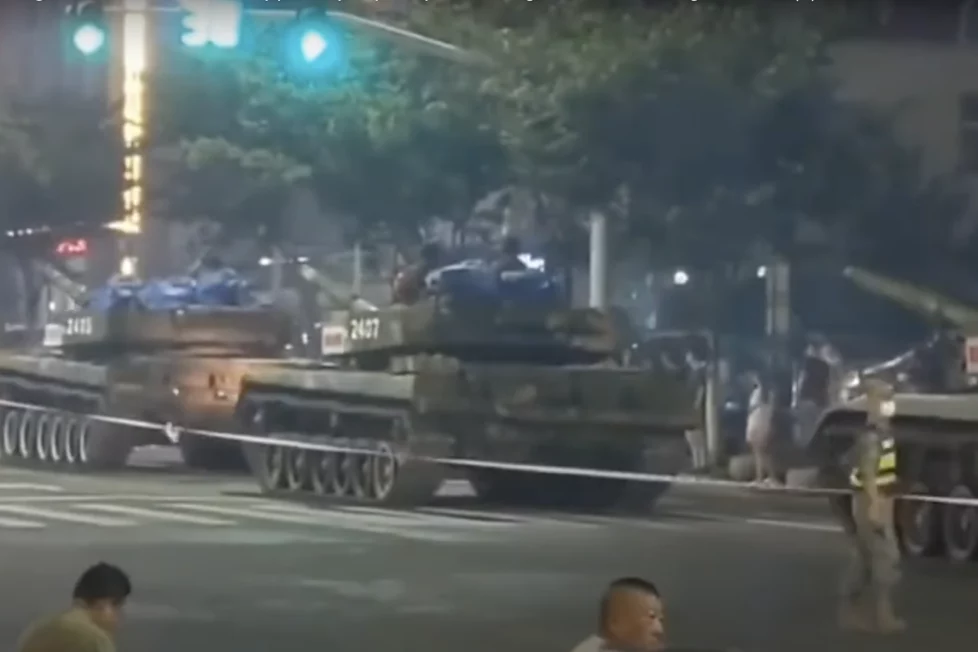China sends tanks into the streets to crush protests by bank depositors seeking their money


To scare away protestors in the midst of a huge bank scam, battle tanks were sent out onto the streets of Rizhao in Shandong Province. Tanks are rolling up in the streets amid the large crowd of protestors gathered at the side of the road. In the footage, numerous tanks can be seen, demonstrating how seriously the CCP leadership intends to put an end to the protests.
People supposedly can’t access the Henan Bank branch on the other side because of the tanks parked beside the road. The banks have frozen deposits, preventing depositors from withdrawing their money which has resulted in a large-scale uprising.
Thousands of people have been protesting for several weeks now, seeking a refund of their deposits. Along with not receiving their deposit money, the depositors are being threatened and harassed for holding protests. According to reports, the police and authorities are pleading with individuals not to take part in protests and have even threatened to fire them if they do. Although the protests are against banks and not the government, the Chinese government has sent in heavily armed forces and tanks to crush them because it is well known that it does not tolerate rallies.
Customers of four rural banks in Henan province—Yuzhou Xinminsheng Rural Bank, Shanghai Huimin Rural Bank, Zhecheng Huanghuai Rural Bank, and Guzhen Xinhuaihe Rural Bank, discovered they couldn’t withdraw their deposits, exposing the fraud. The official explanation was that the accounts were barred by the system because of a problem that occurred during system upgrades. Guzhen Xinhuaihe Village Bank, another bank in the province of Anhui, experienced a similar issue, but it has fewer depositors.
Although there was no further formal statement regarding the matter, the Chinese government declared in May that they were looking into a number of Henan Xincaifu Group shareholders. Furthermore, it was discovered during this investigation that Henan Xincaifu Group had “internal and external collaboration” acquired control of the five rural banks, as well as “illegally” collected deposits. For more than four months, clients were denied access to their money while the criminal investigation was ongoing.
The investigation revealed that the Henan Xincaifu Group conspired with the staff of rural banks to solicit deposits from customers and then used those funds to invest in financial goods through online platforms. By inventing lending agreements, they moved the money from deposit accounts to investments. Depositors’ names were used as the name on investments, but they were unaware of this and never got the large returns that come from such investments.
The banks, however, were promising greater than typical interest in Chinese banks in an effort to draw in more consumers. As a result, they were able to draw clients from across the nation as well as the local area. This was also against the rules because rural banks are supposed to serve exclusively the local population. The Chinese banking regulator claims that Henan altered corporate data to conceal its illicit operations. Additionally, the business did not charge interest on the funds obtained from the banks.
The five rural banks’ own assets rapidly decreased as the majority of the money they had been collecting went to financial markets, putting the banks in danger of going out of business. Banks stopped permitting withdrawals, as a result, starting in April of this year and instructed to “wait patiently.”
The China Banking and Insurance Regulatory Commission (CBIRC) stated that principal payments to consumers would be made in phases. However, the impacted depositors had to make a number of representations before receiving this promise. In fact, on July 10, a group of unknown individuals attacked the protesters.
People with savings under 50,000 yuan (about 5.90 lakh rupees) received their money on Friday as the regulator began paying clients with tiny deposits. However, a system overload is making it difficult for people with bigger deposits to register their claims.
DISCLAIMER: The author is solely responsible for the views expressed in this article. The author carries the responsibility for citing and/or licensing of images utilized within the text.
